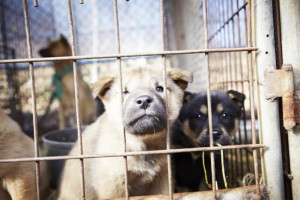By Alyssa Gautieri

Anyone who walks into a local pet store will find it easy to fall in love with the beautiful, sweet, little puppies. Yet people fail to realize that around 90 percent of puppies in pet stores come from puppy mills, according to paws.org, an organization dedicated to helping animals. Animal adoption should be favored, while puppy store shopping should be rejected. The world deserves to know the truth about the horrors of where their pet store puppy came from.
Puppy mills are dog breeding facilities that mass produce dogs for high profits while forcing dogs to withstand shockingly cruel conditions. For years, organizations such as The Puppy Mill Project or National Puppy Mill Project have been trying to spread awareness of these horrors, but some people have refused to listen.
Puppies that grow up in puppy mills are not touched or played with during their time there. They are denied basic rights of cleanliness, as well. According to the American Society for the Prevention of Cruelty to Animals (ASPCA), puppies are separated from their mothers at a young age, so they receive little social interaction. Because they are not taught behavioral and social skills, some dogs grow up to be violent, shy, aggressive, scared or anxious. Most of these puppies avoid human eye contact and shake and cry at the sight of a hand reaching to pet them.
According to the National Puppy Mill Project, the treatment of the dogs at the mill is dismal to say the least.
Most of the puppies born at puppy mills do not receive any medical treatment. Instead, if they are unhealthy, they are either euthanized or given to animal shelters. Puppy mills are all about profit and mass production, so they do not bother to give care to unhealthy animals.
Despite this, puppies from puppy mills are lucky in comparison to their parents. The mothers are kept pregnant and endure litter after litter with no proper veterinarian care. If a cesarean section is necessary, most mill workers will perform the procedure themselves without any anesthesia. Also, mill owners often try to hide how many dogs they have from neighbors so they cruelly debark them, or remove areas of the dog’s tissue from their vocal folds using a tool, such as a scissor.
Facilities often have no free running water, so the dogs are forced to drink from tubes, such as a hamster feeder. When puppy mills are raided, dogs are often found with dirty and rotten teeth, sometimes to the point of having rotten jaws.
In order to minimize feces buildup in cages, dogs often live in cages where floors are made of wire. The floors cause animals to receive serious damage to their paws and legs. These injuries, if overlooked, can lead to infection. In addition, the cages are often stacked on top of one another to maximize space. When not cramped indoors with no sunlight, the puppies are kept completely outside where they are forced to endure all weather conditions.
Shockingly, puppy mills are not illegal. The U.S. Department of Agriculture (USDA) is supposed to monitor and inspect kennels to ensure that they are not violating the housing standards of the Animal Welfare Act. Yet even some mills that are regulated by the Animal Welfare Act are still considered inhumane. Under the act, it is legal to keep dogs in small, wired and stacked cages for the entirety of the dogs’ lives. But according to The Humane Society of the United States, there are an estimated 10,000 puppy mills in the United States and fewer than 3,000 of them are actually regulated by the USDA.
For the USDA, regulating puppy mills is a low priority because of the cost and time consumption. Before a mill is raided, officials must obtain warrants. Once a mill is raided, the dogs need to be provided expensive health care and need to be found homes on short notice. According to the ASPCA, there can be anywhere from 10 to 10,000 dogs in a puppy mill.
When consumers shop online or at pet stores, they give breeders the capacity to continue raising powerless puppies in unsanitary conditions.
Every day, puppy mills are raided and more dogs are put up for adoption at shelters. While puppy mills are mass producing puppies for exorbitant profits, shelters are overcrowded with dogs searching for love. With adoption, buyers know what they are purchasing because they are able to track where the animal came from, whereas puppy stores try to allude (to the few customers that bother to ask) that their animals come from reliable breeders.
When choosing a new pet, buyers have the power to change how dogs of the future will be treated. For the puppy mills that continue to be overlooked by the government, buyers are supporting the cruelty and pain that breeders inflict onto dogs whenever they shop at pet stores. If the public would stop buying pets from pet stores, the puppy millers would be forced to stop breeding. The power is in the hands of the public to put an end to this cruelty. Adopt, don’t shop.
Students share opinions around campus
Should puppy mills be illegal?

“Yes... It’s just not right.”

“No... (I think) it’s up to the people to decide... (but puppy mills) should be kept in check with more standards.”






